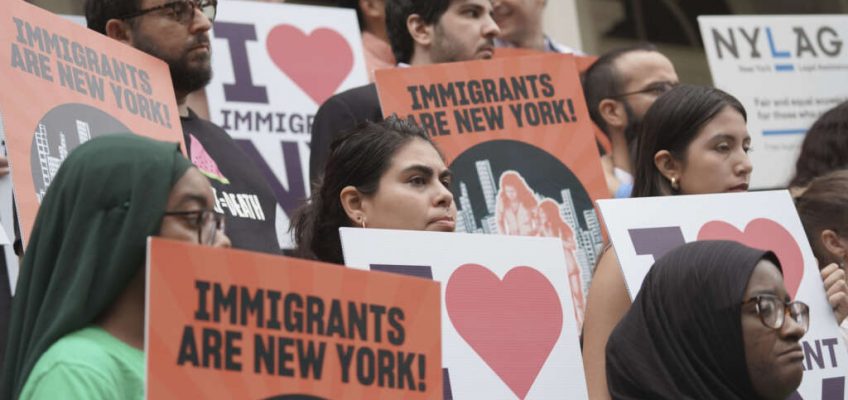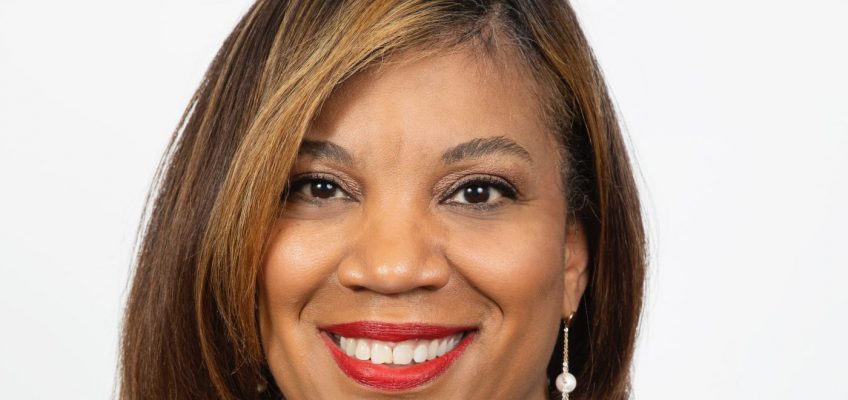El plan de gastos incluye un aumento en la financiación de los servicios de asesoría legal de inmigración, lo que un defensor calificó como “una victoria importante”. Una iniciativa que ha generado preocupación por la excesiva vigilancia es la creación de un nuevo departamento que regule las bicicletas eléctricas de los repartidores de comida, en su mayoría inmigrantes.
Una manifestación en el Concejo Municipal a finales de junio pidiendo más fondos para servicios legales de inmigración en el presupuesto de este año. (Gerardo Romo / Ayuntamiento de Nueva York)
Este artículo se publicó originalmente en inglés el 10 de julio. Traducido por Victoria Moran Garcia. Read the English version here.
A finales del mes pasado, el alcalde Eric Adams y el Concejo Municipal revelaron detalles del presupuesto de casi $116 mil millones de dólares de la ciudad para el nuevo año fiscal, que comenzó el 1 de julio.
A diferencia de anteriores negociaciones presupuestarias, en las que el alcalde y los legisladores discutieron fuertemente sobre los recortes presupuestarios, en esta ocasión varios programas que afectarán directamente a las comunidades inmigrantes de la ciudad recibieron más fondos.
Esto incluye dinero adicional para servicios legales gratuitos —que los defensores dicen que son necesarios ahora más que nunca mientras la administración Trump persigue deportaciones masivas—, y también para programas de cuidado infantil abiertos a neoyorquinos de cualquier estatus migratorio.
El presupuesto también financiará una nueva iniciativa dentro del Departamento de Transporte para supervisar a los repartidores de comida, que incluye regulación para bicicletas eléctricas. Los defensores del sector temen que esto pueda dar lugar a un exceso de vigilancia del sector, donde gran parte de la población es inmigrante.
Aquí un resumen de lo que el acuerdo presupuestario incluye para los inmigrantes neoyorquinos.
Impulso a servicios legales
Entre las iniciativas clave se incluyen $74.7 millones para servicios legales de inmigración. En esta categoría se encuentran los servicios jurídicos para inmigrantes con bajos ingresos que recibió el mayor aumento, pasando de $4.4 millones de dólares en el año fiscal 2025 a $33.2 millones de dólares este año, un aumento de más del 600 por ciento.
La financiación “garantizará la continuidad de los servicios y ayudará a defender a los inmigrantes frente a las actuales políticas agresivas y contrarias a la inmigración”, dice el presupuesto.
Los defensores de los inmigrantes aplaudieron los fondos adicionales, que llega en un momento en que los agentes del Servicio de Inmigración y Control de Aduanas de Estados Unidos (ICE por sus siglas en inglés) llevan a cabo detenciones más visibles de inmigrantes en las calles de la ciudad y al salir de los tribunales de inmigración.
Murad Awawdeh, presidente y director general de la New York Immigration Coalition, dijo que el acuerdo presupuestario “es una importante victoria para los inmigrantes y los neoyorquinos con bajos ingresos”.
El presupuesto también aumentó los fondos para la asesoría legal de niños inmigrantes en proceso de expulsión, pasando de $3.9 millones de dólares en el año fiscal 2025 a $16.5 millones de dólares en el año fiscal 2026: un aumento del 323 por ciento. Esto se produjo después de varios años de insistencia de los defensores para obtener más fondos, tras ver que no aumentaba por más de cuatro años.
El dinero apoyará evaluaciones legales y representación legal para menores no acompañados y familias. Desde 2022, decenas de miles de solicitantes de asilo y migrantes han llegado a la ciudad, lo que ha provocado un aumento en el número de jóvenes inmigrantes no acompañados.
Este año la necesidad de abogados ha aumentado por los recortes de fondos federales para servicios legales a menores y la mayor presión de la administración Trump.
Aunque los defensores celebraron el aumento, dicen que sigue siendo insuficiente.
“No equivale a que todos los niños tengan representación completa en la ciudad de Nueva York”, dijo Sierra Kraft, directora ejecutiva de la Immigrant Children Advocates Relief Effort coalition, “pero sí demuestra un liderazgo y un compromiso a no dejar dejar a los niños vulnerables sin apoyo”.
Kraft añadió que son fondos por un solo año y que los proveedores de servicios jurídicos tendrán que gestionar la contratación y la dotación de personal a medida que los jueces aceleran los procesos judiciales, lo que dificultará que los proveedores puedan satisfacer la demanda.
“Hemos visto un aumento en el número de jueces de inmigración que avanzan rápidamente los casos, incluso si el menor no acompañado no tiene un abogado”, dijo Kraft. “Así que estamos tratando de seguir cuidadosamente cuántas veces, cuántas apariciones tienen los jóvenes antes de obtener una orden de expulsión”.
El alcalde Eric Adams y la portavoz del Concejo Municipal Adrienne Adams estrechan sus manos sobre el acuerdo presupuestario de este año el 27 de junio de 2025. (Ed Reed/Oficina de Fotografía de la alcaldía)
Una tercera iniciativa que recibió más apoyo fue el New York Immigrant Family Unity Project (NYFUP por sus siglas en inglés), que se lanzó en 2014 para brindar ayuda legal a inmigrantes que se encuentran en centros de detención y pueden enfrentar la deportación. A diferencia de los casos penales, en los tribunales de inmigración no está garantizada la asistencia jurídica.
La financiación de NYFUP aumentó un 50 por ciento este año, pasando de $16.6 millones de dólares durante el último año fiscal a $24.9 millones de dólares.
Otro programa que recibió más fondos es la Colaboración Legal de Respuesta Rápida (RRLC por sus siglas en inglés), que también cuenta con el apoyo del estado a través de su Oficina para Nuevos Americanos. Este programa ayuda a las personas detenidas o en riesgo de ser detenidas y deportadas.
“Se ha incrementado la inversión, lo que refleja lo que estamos viendo sobre el terreno: un aumento de las detenciones y deportaciones de personas y familias”, dijo Jodi Ziesemer, codirectora de la unidad de protección de inmigrantes de New York Legal Assistance Group, uno de los tres proveedores de servicios legales que forman parte de RRLC.
“Violando las normas del debido proceso, este aumento de la aplicación de la ley de inmigración incluye a personas que tienen familiares ciudadanos estadounidenses, que pueden ser elegibles para el alivio de la inmigración y que merecen una oportunidad de ser escuchados”.
El presupuesto también incluye $3 millones de dólares para las organizaciones que apoyan a supervivientes de la violencia doméstica en las comunidades inmigrantes a través del programa Culturally Specific Gender Based Violence Initiative, sobre la que escribieron la semana pasada la presidenta del Concejo Adrienne Adams y la concejal Sandra Ung.
Cuidado infantil y cámaras corporales
El presupuesto de 2026 incluye $10 millones de dólares para lanzar un programa piloto de cuidado infantil universal que proporcione atención gratuita a cientos de niños menores de dos años.
Un portavoz del Concejo de la ciudad dijo que el nuevo programa está abierto a todos los neoyorquinos, independientemente de su estatus migratorio (aunque ni la alcaldía ni la Oficina del Alcalde para Asuntos del Inmigrante, o MOIA por sus siglas en inglés, respondieron cuando se les hizo esta pregunta).
La ciudad también sigue proporcionando $25 millones de dólares en fondos para programas de educación infantil para familias indocumentadas con el programa Promise NYC, que brinda cuidado infantil a familias que no califican para otros programas.
Además, los agentes de policía del Departamento de Sanidad de la ciudad de Nueva York (DSNY por sus siglas en inglés) recibirán equipos de cámaras corporales. DSNY no respondió a las preguntas sobre este cambio.
Pero el Street Vendor Project, un grupo que aboga por los vendedores locales (la mayoría de los cuales son inmigrantes), dijo que han estado presionando para que la policía del DSNY use cámaras corporales desde que el departamento se hizo cargo de la vigilancia de las ventas ambulantes en 2023.
“Como agencia policial, creemos que es importante que el DSNY (así como Parks Enforcement Patrol del Departamento de Parques) tenga una supervisión tan estricta como la policía de Nueva York, y nos alegramos que el presupuesto incluya este elemento”, dijo Carina Kaufman-Gutiérrez, subdirectora de la organización.
“En el futuro, también nos gustaría que la patrulla de parques tenga cámaras corporales y la implementación de una agencia externa similar a la Junta de Revisión de Quejas de Civiles que monitoree o aborde las quejas contra agentes del orden público”, añadió.
Repartidores de comida fotografiados en una rueda de prensa con concejales en 2022. (John McCarten/Unidad de Medios de la alcaldía de Nueva York)
Departamento para repartidores de comida
El presupuesto incluye $6.1 millones de dólares para un nuevo departamento llamado “Department of Sustainable Delivery” dentro del Departamento de Transporte que regule las bicicletas eléctricas comerciales.
Este departamento es un viejo objetivo del alcalde Eric Adams. Lo propuso en su tercer discurso sobre el estado de la ciudad en enero de 2024 como “una entidad pionera en el país que regulará las nuevas formas de transporte de reparto y garantizará su seguridad”.
Actualmente, se sabe poco sobre cómo funcionará el departamento. “En realidad, aún no existe un marco para el departamento. Está incluido en el presupuesto como un elemento propuesto por la alcaldía, pero su creación requeriría una acción legislativa del Concejo Municipal”, dijo Mara Davis, la subsecretaria de prensa del Concejo.
Davis rebatió la afirmación del alcalde Adams sobre que es el Concejo el que no está avanzando con la legislación para crear el departamento.
“Eso simplemente no es cierto. El Concejo no está estudiando actualmente ninguna ley; estamos esperando a que la pongan sobre la mesa, y en realidad es un concepto suyo”, dijo Davis.
La alcaldía remitió las preguntas de City Limits sobre la iniciativa a un comunicado de prensa que emitió el lunes la alcaldía.
El comunicado decía que el departamento “realizará medidas contra el uso ilegal de ciclomotores, bicicletas eléctricas y scooters eléctricos; responsabilizará a las compañías de aplicaciones de entrega asegurándose que los repartidores comerciales utilicen equipos seguros y legales, y que las empresas de reparto se enfrenten a las repercusiones de comportamientos inseguros; y abordará los comportamientos de estacionamiento de vehículos que ponen en peligro a peatones, ciclistas y conductores de bicicletas eléctricas”.
Tendrá 45 “agentes de la paz” (peace officers) encargados de dar infracciones de circulación y de hacer cumplir a las empresas las leyes sobre el uso de la bicicleta con fines comerciales, aunque el despliegue de estos agentes no está previsto hasta el 2028.
El nuevo departamento afectaría directamente a los aproximadamente 65,000 repartidores de comida de la ciudad.
A los defensores les preocupa que solo criminalice aún más a los trabajadores y ponga a muchos en riesgo de deportación, en un momento en que la administración Trump está tomando medidas enérgicas contra los inmigrantes.
Ligia Guallpa, directora ejecutiva de Workers Justice Project —la organización sin fines de lucro que apoya a Los Deliveristas Unidos y que aboga por los repartidores—, dice que este departamento no es la solución para protegerlos ni para garantizar la seguridad en las calles.
Guallpa dice que le preocupa la falta de información sobre el departamento, así como el enfoque que sugiere el lenguaje de la alcaldía al respecto. “En lugar de proteger a los trabajadores, de exigir responsabilidades a corporaciones multimillonarias de aplicaciones, [el enfoque] ha sido más hacia la regulación de las e-bikes, y con ello, la regulación de los repartidores”.
Guallpa dice que los funcionarios electos deberían centrarse en regular a las empresas de reparto y garantizar la protección de los repartidores. Ella dice que los requisitos de tiempo de entrega poco realistas crean presión sobre los trabajadores que no pueden darse el lujo de perder sus empleos.
“Si en verdad quieren que los deliveristas prioricen la seguridad en la calle”, dijo Guallpa, “empieza por darles los derechos legales para que puedan combatir la presión y las represalias que están sufriendo [de] las apps”.
Esto llega en un momento en que los defensores ya están preocupados por un cambio que permite a la policía de Nueva York dar citaciones penales en lugar de multas de tráfico a los ciclistas. Gualpa dice que los repartidores suelen ser uno de los principales objetivos de estas medidas.
“La policía de Nueva York y el alcalde de la ciudad [han] creado una asociación para empezar a criminalizar y crear una vía para la deportación potencial y la persecución de los trabajadores inmigrantes”, dijo Gualpa. En su lugar, WJP quiere ver carriles para bicicletas físicamente protegidos, educación dirigida por la comunidad sobre seguridad en las calles para los deliveristas y estaciones de carga, entre otros cambios de infraestructura.
“Creemos y rediseñemos nuestras calles para adaptarlas a la nueva realidad de nuestros barrios y nuestra ciudad”, dijo Guallpa.
Para ponerse en contacto con los reporteros de esta noticia, escriba a Daniel@citylimits.org o a Victoriam@Citylimits.org. Para ponerse en contacto con la editora, escriba a Jeanmarie@citylimits.org.
The post ¿Cómo afecta el último presupuesto de Nueva York a las comunidades de inmigrantes? appeared first on City Limits.




